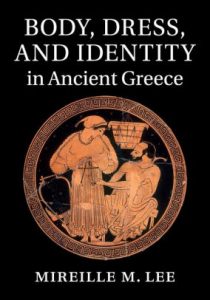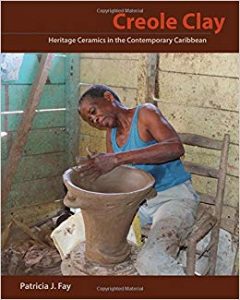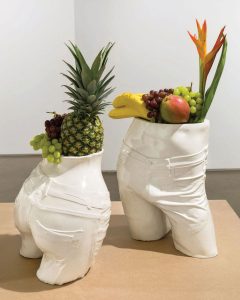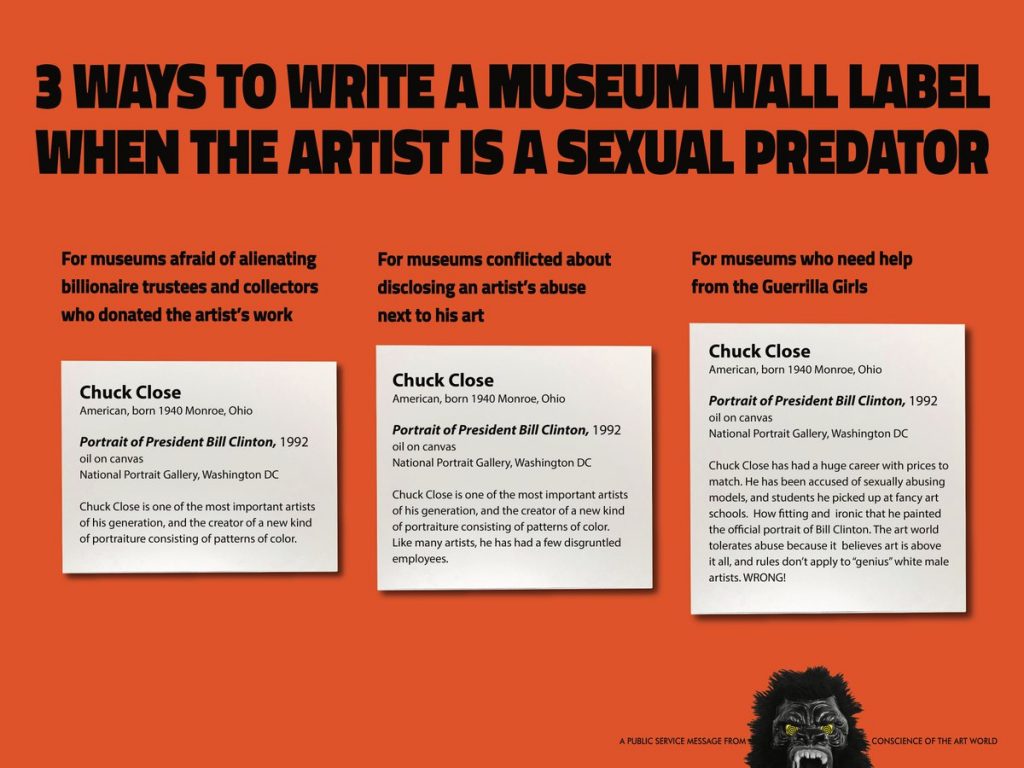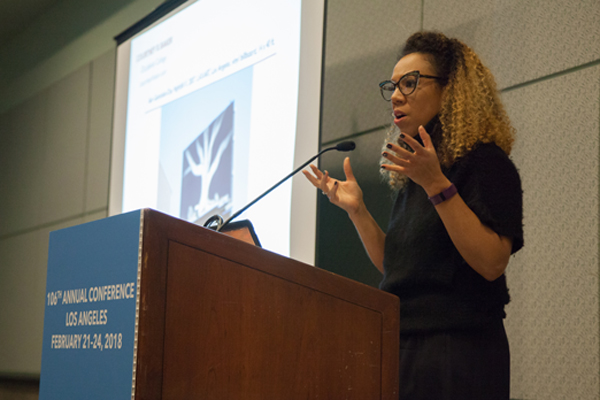CAA News Today
Martha Hollander and Tyler Rockey
posted by CAA — October 08, 2018
The weekly CAA Conversations Podcast continues the vibrant discussions initiated at our Annual Conference. Listen in each week as educators explore arts and pedagogy, tackling everything from the day-to-day grind to the big, universal questions of the field.
CAA podcasts are now on iTunes. Click here to subscribe.
This week, Martha Hollander and Tyler Rockey discuss web-based tools and approaches in the art history classroom.
Martha Hollander is a professor of art history at Hofstra University. Tyler Rockey is an adjunct professor of art history at Neumann University.
New in caa.reviews
posted by CAA — October 05, 2018
Mary Harlow writes about Body, Dress, and Identity in Ancient Greece by Mireille M. Lee. Read the full review at caa.reviews.
Brian Snapp reviews Creole Clay: Heritage Ceramics in the Contemporary Caribbean by Patricia J. Fay. Read the full review at caa.reviews.
Matthew Irwin discusses the exhibition Puerto Rico: Defying Darkness at 516 Arts, Albuquerque. Read the full review at caa.reviews.
CWA Picks for October 2018
posted by CAA — October 04, 2018
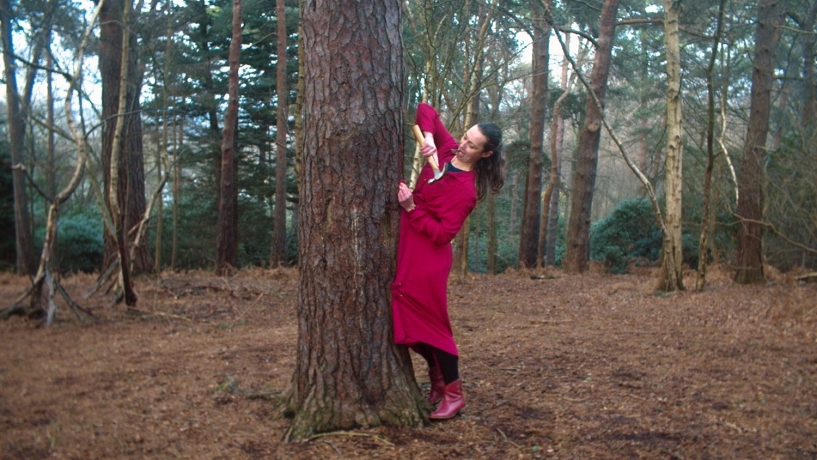
Noor Afshan Mirza and Brad Butler, The Scar, 2017. Film still. Courtesy the artists and Delfina Foundation.
CAA’s Committee on Women in the Arts selects the best in feminist art and scholarship to share with CAA members on a monthly basis. See the picks for October below.
Liliane Lijn: Cosmic Dramas
September 13 – December 7, 2018
Rodeo Gallery (Piraeus, Greece)
For its first show of the season in its new venue in Athens, Rodeo introduces the work of still understudied “un-feminist feminist” and kinetic-art pioneer, Liliane Lijn. The show includes a suite of drawings and a multimedia sculptural installation comprising two of the 1980s “goddesses” that exemplify Lijn’s multidisciplinary practice, interests, and radical exploration of the feminine, and resonates with the cultural background of Athens (a city where Liliane Lijn also lived in the early 1960s).
Conjunction of Opposites combines two figures The Lady of the Wild Things (1983) and The Woman of War (1986) made separately, when, in the 1980s, Lijn turned to an exploration of the feminine through apparitions of feminine energy and power. Ahead of their time, but in line with Lijn’s interests in science, technology, language, light, movement, mythology, and eastern philosophies characterizing her pioneering contribution to the 1960s avant-garde, they are computer controlled, combining LED lights and laser beams with an array of traditional and everyday materials, such as smoke and brush fibers. The Lady of the Wild Things is a bird goddess representing the lunar archetype and a machine activated by sound. The Woman of War is a singing goddess, the embodiment of an angry song that the artist felt came straight through the earth to her mouth. Their hybrid (mechanic and organic) bodies, as described by the artist—were combined in 1986 in an interactive installation that created a mesmerizing spiritual and sensual drama, staging an exchange of poetry and light in a cloud of artificial fog. When together, a laser light connects these “performative sculptures” through a disembodied beam of red light bouncing between their heads, activated by the six minute drama unraveling in Lijn’s voice.
These figures are “drawing together our mythological past for an imagined future, ” the artist has eloquently reminisced about their making. Underpinning her statement is a connection between the sacred and modern industry important to this work and Lijn who observes that many of the holiest places consecrated to the Goddess in ancient times, like Eleusis near Athens, are now transformed into oil refineries and power stations, wondering what archetypes might be hidden in the “bowels of steel mills or the endless intestines of oil refineries?” But while each sculpture distills symbolic references to female archetypes and mythological beings, embodying elements of seduction, power and spirituality, interacting in Conjunction of Opposites they shatter binary notions of gender “evoking femininity as a fluid cosmic fact,” conveying the radicalness and timeliness of Lijn’s exploration of the feminine that this show tries to show, and that variously connects the lasting manifestations of her feminist concerns with her “un-feminist” feminist turn away from fixed understanding of femininity through her turn to science and technology in the 1960s.
Liliane Lijn has lived and worked in London since the late sixties, after straddling the most radical and unexpected contexts and milieus of the postwar avant-garde—Paris, where she studied archeology, New York, and even Athens, where she lived with her then-partner Takis. She was born in New York to parents of Jewish Russian origins who escaped World War II through Cuban passports, and she grew up in various US cities and Switzerland.
RONNI KOMAROW: TENDER MERCIES
October 3-28, 2018
Galatea Fine Art (Boston)
Artist Ronni Komarow’s solo show is centered on an interactive installation, Diary of a Bake Sale Diva, comprised of 400 hand-made papier-mâché cupcakes juxtaposed against the walls lined with 120 feet of hand-written, multi-hued script of comments, queries and inner musings around her experience as bake-sale coordinator for her son’s middle school. The visual display emits a playful vibe, with a relevant examination of public school funding today. Visitors are also invited to write with chalk on a blackboard their own bake sale experiences, exuding the artist’s community-driven ideals.
Exploring motherhood in art isn’t new but certainly the narratives explored often involve early parenthood and pregnancy; Komarow, rather, looks captivatingly at raising adolescents and the maneuvering and intermixing of motherhood, community service, school activities and artmaking. The exhibit title reflects the “tender mercies that have enriched her life, even if given inadvertently,” as so many aspects of motherhood, relatably, are. The exhibit includes artist books related these themes, also combining imagery and text, an accessible, refreshing element of the entire exhibit, in contrast to the oft-highbrow conceptual exhibitions reserved for the few.
Contemporary Muslim Fashions
September 22, 2018 – January 6, 2019
de Young Museum (San Francisco)
From the abaya to the hijab to the ‘burkini’—this wide-ranging exhibition explores the dynamism of Muslim fashion—at a moment when social and political hostilities towards muslims is at an all time high. For this reason alone the exhibition should be required viewing. Following on the heels of other travelling ‘blockbuster’ fashion exhibitions at the de Young (Jean-Paul Gaultier and Vivienne Westwood are two recent monographic examples), this show feels constituitively different, with its emphasis on religious life, culture, and expression. Curated by Reina Lewis, who teaches cultural studies at the University of the Arts London and the London College of Fashion, an in consultation with muslim fashion leaders in the Bay Area, the show is careful never to spectacularize the fashion on display (a mainstay of blockbuster fashion shows), but uses the garments as a jumping off point to consider religious life, Orientalism, subjugation and liberation (many of the mannequins wear hijabs, but some do not—reflecting the diversity of opinion as to whether or not the enforcement of the wearing of the hijab is an oppressive religious dictat).
Dian Pelangi is a recurring and innovative presence in the exhibition. One ensemble (pants, skirt, jacket, top, headscarf and cap) plays with different familiar Islamic forms—patterning commonly found in tiling and screens (mashribiyas). Pelangi’s designs as well as many others in the exhibition make the point with clarity that Muslim communities are not homogenous or monolithic.
Noor Afshan Mirza and Brad Butler: The Scar
September 27 – December 1, 2018
Delfina Foundation (London)
“Inhaling patriarchy and exhaling wo(fem)inism,” is how Noor Afshan Mirza captures the importance and the gender revolution ignited in The Scar, the film she and Brad Butler produced during their Delfina Foundation residency in London in 2015. In this installation the film appears in the form of an immersive five-screen video installation.
Inspired by a true event and comprising three chapters (The State of the State, The Mouth of the Shark and The Gossip), The Scar combines conspiracy, gangster, noir, politics, crash theory, fantasy and reality into a disrupted and disruptive narrative. Chapter one features four passengers on a journey in a black Mercedes, unaware of their significance as state archetypes. The fourth passenger is Yenge, the only female traveller, silenced by the genre conventions of women in film. Yenge’s noir voiceover begins to interrupt the male characters’ forced bravado in chapter two, as they are haunted by the Resistant Dead – the residual movements created from stories of people refusing to be forgotten. Tales of female emancipation and empowerment, are addressed in the last chapter, where a group of female activists transcend time, geographical borders and linguistic barriers to gather in a neutral nether-realm of conversation and mutual support. Like most of the work of this radical collaborative duo based The Scar takes on, and deconstructs, urgent and complex narratives around our relationship to state power engaging issues of inequality and corruption, while proposing a post-patriarchal near future.
Founders of the London-based center for artist film production no.w.here, and known for their fictional construct The Museum of Non Participation, (2008-20016) Mirza and Butler create work which spans the moving image, installation, sound, text and performed actions and explores themes of resistance, inequality, power and privilege, and (non) participation while questioning the deep state, narration, neoliberalism and investigating the use of women’s bodies as sites of resistance.
Suellen Rocca: Drawings
September 14 – October 27, 2018
Matthew Marks Gallery (New York)
“Suellen Rocca is one of the original members of the Hairy Who, the influential group of six Chicago artists who exhibited together for five years in the 1960s. This show, the first to concentrate on Rocca’s works on paper, presents thirty drawings she made between 1981 and 2017. Building on the unique graphic vocabulary and innovative compositions of her 1960s work, these drawings represent a turn toward imagery she describes as ‘more internal.’ Animals, trees, and unclassifiable creature are placed in densely patterned settings that carry a genuine emotional charge.
The exhibition is accompanied by a fully illustrated catalog. In the essay, Cat Kron notes Rocca’s “increased attention to the unconscious,” tracing parallels between the artist’s ‘anxious imaginings’ and the automatic drawing of the Surrealists. As Rocca puts it, ‘I just begin, and the drawing is a journey between me and the marks on the paper.’” (Matthew Marks; Press Release)
Alexandra Bachzetsis: An Ideal for Living
September 8 – December 9, 2018
Centre Culturel Suisse (Paris)
A choreographer and visual artist based in Zürich, Alexandra Bachzetsis is known for works in space that radically cut across the boundaries between dance, performance art, visual arts and theater and use the body as an artistic and critical apparatus. Her work investigates the choreographies of the body and how culture provides source material for its gestures. Through an interdisciplinary approach that often explores the role of popular culture and art play in the way in which bodies are inhabited and performed through choice and cliché, her works open emancipatory possibilities of transformation and communication.
An Ideal for Living, an exhibition specially conceived for Centre Culturel Suisse in Paris, focuses on Bachzetsis’ exploration of the subject of bodies over time and its subversive potential. Using various garments and accessories in a process of constructing imagination and desire, the artist explores ways in which bodies and objects are reversible, drawing inspiration from vogue culture. The exhibition comprises an installation of three simultaneous video projections in which a pair of teenagers, a boy and a girl with an uncanny resemblance, act out real-life situations and sing songs. It also includes low platforms that invite the visitors to strike poses or sing out loud, along with various gym equipment on which to warm up and shape up one’s body. Suggesting the potentially subversive ambiguities of body language, An Ideal for Living keeps posing the rather crucial question for efficient body politics, in the words of Paul B. Preciado: “Are you a Platonist of political anatomy or a Nietzschean of bodily movement? Are you more object or subject? How do you select your gestures? Have you ever stolen a gesture? Will you ever invent one?”
News from the Art and Academic Worlds
posted by CAA — October 03, 2018
Spelman College Awarded $5.4 Million Grant to Increase Diversity in Museum Field
The grant will establish the Atlanta University Center Collective for the Study of Art History and Curatorial Studies. (Press release)
The Guerrilla Girls Are Helping Museums Contend With #MeToo. Read Their Proposed Chuck Close Wall Labels Here
The feminist collective shows how to call out—or gloss over—accusations against artists accused of sexual misconduct. (artnet News)
Research Study: Impact of Art Museum Programs on K–12 Students
This study builds on and amplifies previously limited research on the impact of art museum programming. (NAEA)
Guggenheim Museum Announces Free Admission for Students, Faculty, and Staff at Five CUNY Schools
The museum’s new program will provide over 100,000 New York City college students with free admission. (Press release)
The Getty to Start a Research Center for African-American Art
The Getty’s initial partners include the Studio Museum in Harlem, the California African American Museum, Art+Practice, and Spelman College. Dr. Kellie Jones, 2018 CAA awardee for Excellence in Diversity, will be a senior consultant for the project. (New York Times)
Seven Tips for Greater Accessibility at Events
“In 2018 accessibility means more than a ramp or an elevator. It means giving everyone a chance to experience your presentations, events, exhibits, and collections.” (American Alliance of Museums)
Registration Now Open for the 2019 CAA Annual Conference
posted by CAA — October 02, 2018
2019 CAA Annual Conference
New York Hilton Midtown
February 13-16, 2019
Four days for everyone in the arts with over 300 sessions and panels, dozens of receptions and parties, professional development workshops, lightning talks, and exhibitors. #CAA2019 #CAANYC
The CAA Annual Conference returns to New York in 2019. From February 13-16, at the New York Hilton Midtown, we welcome all those in the visual arts to attend over 300 sessions and professional development workshops, and dozens of receptions, parties, and special tours at local museums and cultural institutions. The Book and Trade Fair and the Cultural and Academic Network Hall, with hundreds of booths showcasing the latest products, programs, and books, will occupy three floors of the Hilton New York Midtown. Our partners offering free admission and special tours this year include The Frick Collection, The Morgan Library & Museum, The Jewish Museum, Dia Art Foundation, the Rubin Museum of Art, the New York Public Library, the Neue Galerie, and many others.
The 107th CAA Annual Conference content will address the full breadth of the field of visual arts and design and examine a range of cultures, histories, and scholarship. We anticipate more than 5,000 professionals in the arts to attend the conference in New York. Sessions will include “Below the Mason-Dixon Line: Artists and Historians Considering the South,” “Deskilling in the Age of Donald Trump,” “Immigration and Inclusion in Art Museums,” “Supporting Immigrant Artists and Communities,” “Mapping Crime,” “Endangered Data,” and “Racist Human Mascots: A Guide for Artists and Designers to Determine the Qualifications of Racism in Commercialized Art,” among hundreds of other panels.
The Distinguished Scholar for the 107th CAA Annual Conference is Dr. Elizabeth Boone, the Martha and Donald Robertson Chair in Latin American Studies at Tulane University. Dr. Boone specializes in Pre-Columbian and early colonial art of Latin America.
New this year, the CAA Annual Conference will feature twenty professional development workshops supported by The Emily Hall Tremaine Foundation. The workshops add to CAA’s annual workshop offerings for a total of thirty available workshops at the Annual Conference. The Emily Hall Tremaine Foundation workshops will be led solely by MFA candidates and adjunct faculty with the aim of strengthening practical, hands-on skills for studio artists as well as providing professional development opportunities.
Once again, CAA will offer a number of travel grants and scholarships to individuals looking to attend the Annual Conference. With the generous support of Blick Art Materials and Routledge, Taylor & Francis, CAA will provide eight student member registrants with $250 each to attend the conference.
We look forward to seeing you in NYC!
Please contact Member Services at membership@collegeart.org or at 212-691-1051, ext. 1 with any questions.
Help Art History Teaching Resources (AHTR) Teach the Importance of Design History
posted by CAA — October 01, 2018
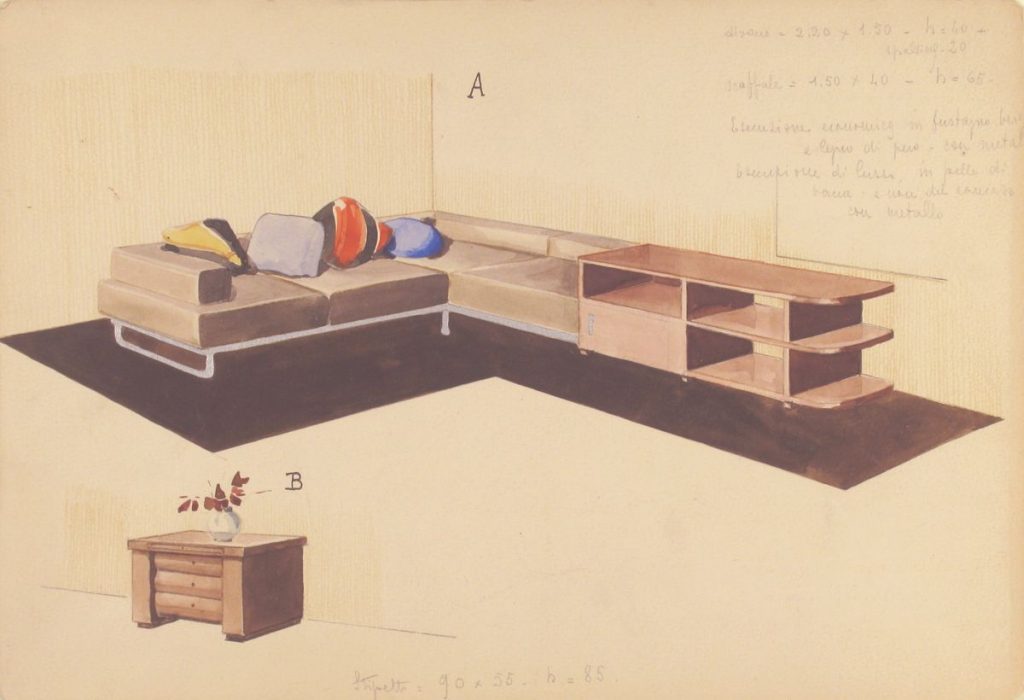
Guglielmo Ulrich, Divano, seoffale, e stipetto [Perspective of L-Shape Sofa and Storage Unit], 1933, watercolor and black and metallic ink, over graphite, sheet: 11 1/8 × 7 9/16 in. (28.2 × 19.2 cm). Collection of the Metropolitan Museum of Art.
ArtHistoryTeachingResources.org
Funding Sought: $4,000
Every day, across thousands of universities and high schools in the US, students learn about the history of art from prehistory to the present. Very rarely is design history incorporated into this curriculum. Art History Teaching Resources (AHTR)—a non-profit teaching resource site in the visual arts—wants to change this.
AHTR has collaborated with CAA’s Committee on Design to propose an initial collection of online teaching resources related to design history of the last two hundred years that will enable university-level and AP instructors to confidently teach them in foundational art and design history survey classes. The resources will be hosted online at arthistoryteachingresources.org in an area clearly marked as “design history” content.
Like AHTR’s existing resources already, the Design History Teaching Resources will include scholarly, well-researched, and peer-reviewed lecture outlines, image clusters, and bibliographies, as well as innovative digital videos and links to other Open Educational Resources (OERs) for students and teachers. The resources will remain freely accessible and open to all under a Creative Commons license.
To realize these resources AHTR needs to raise a modest sum of $4,000. If you might consider supporting this venture with a donation large or small, and would like to see the budget outline, timeline for completion, or any further details about the project, please contact: info@arthistorytr.org
Janis Chakars and Martha Lucy
posted by CAA — October 01, 2018
The weekly CAA Conversations Podcast continues the vibrant discussions initiated at our Annual Conference. Listen in each week as educators explore arts and pedagogy, tackling everything from the day-to-day grind to the big, universal questions of the field.
CAA podcasts are now on iTunes. Click here to subscribe.
This week, Janis Chakars and Martha Lucy discuss art education in a visual society within the context of the Barnes Foundation.
Janis Chakars is associate professor of communication and digital media, Neumann University. Martha Lucy is deputy director for research, interpretation and education at the Barnes Foundation.



